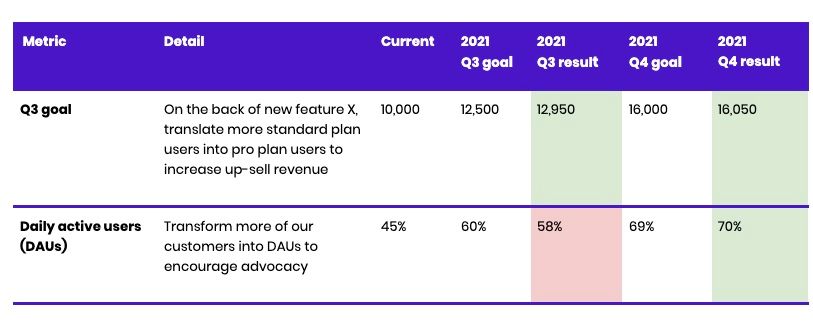OKRs were first developed by Peter Drucker, the founder of modern management, in the '50s.
Since then, they’ve been repackaged by countless other business influencers but really caught fire once-legendary investor (and author) John Doerr brought the framework to Larry Page at Google, and in Larry’s own words, “OKRs helped lead us to 10x growth, many times over. They’ve helped make our crazily bold mission of ‘organizing the world’s information’ perhaps even achievable. They’ve kept me and the rest of the company on time and on track when it mattered the most.”
Implementing a framework used by a global technology conglomerate at a small-scale start-up may seem daunting, after all at this stage of growth your goals will be wildly different, however as you’ll come to find out the beauty of OKRs is that anyone can set measurable goals!
In this article, we’ll focus on:
What are OKRs?
OKR stands for objectives and key results, their purpose is to help companies, teams, and individuals set goals and strategies in manageable chunks. These goals can be used for anything from performance to productivity, and they're all about setting objectives and getting measurable results.
OKRs are usually set across a defined period of time to track progress, maintain progression, and introduce contingency plans when needed.
Why are OKRs important?
OKRs are a great way for companies to motivate and align teams to work towards common objectives, and on an individual level they're a great way to demonstrate the value you bring to the table.
And while there’s no definitive one-size-fits-all approach for start-ups when it comes to OKRs, there are a few steps you can take to implement this framework for success.
Implementing OKRs in 5 steps
1. Introduce them to your team
Before rolling out any kind of new framework, communication is key.
Explain the concept of OKRs to your team, and what you hope to achieve by implementing them. Outline the timelines you plan to use to measure their success (monthly, quarterly) and most importantly discuss the procedures around deliverables, progress checks and what to do if any problems arise.
2. Define OKRs
Define your specific objectives by asking yourself three simple questions.
- Where am I now?
- Where do I want to go?
- How do I get there?
Your answers will form the outline of the OKRs for every team member within your given timeframe. For example, your objective might be to reach out to 30 potential new clients over the next month, taking meetings with at least 15 within two months and sealing the deal with 10 over the next quarter.
Once the rest of your team are aware of your objectives, they can break them down into bite-sized tasks or relevant metrics to help the company achieve that goal, whether that's by adding features to entice a certain type of client or resolving customer issues for better feedback.
3. Regular check ins
Discussing OKRs at the start and the end of each cycle just isn’t enough.
Regular check-ins to see how objectives are progressing and whether individuals are on track to meet their targets are vital to everyone achieving their goals.
Schedule weekly or bi-weekly one-on-ones with team leads to see if you can provide guidance or assistance to help them reach their target. Keeping on track ensures you have enough time to achieve what you set out to without having to scramble for time as the quarter comes to an end.
4. Measure your OKRs
You can measure OKRs by implementing a scoring system.
California's Chief Innovation Officer, Rick Klau recommends scoring key results between 0.0 to 1.0, however, 0% to 100% are perfectly acceptable too.
To calculate the score, we divide the target set by the result, so for example if sales had a target of calling 1,000 leads but only managed to call 400, their score would be 0.4, if they called 800, then the score is 0.8. Once you have the score, you can grade the key result using this grading system as a guide.

5. Establish feedback loops
It will take time for you and your team to get used to the process of OKRs, and you might not have all of the right metrics in place at the very start, but once you’ve completed a few cycles you’ll get a better feel for realistic timelines and how long certain processes actually take.
It’s so common to underestimate the time it takes others to complete certain tasks or overestimate how much users are going to love a certain feature, but that’s the beauty of OKRs, even if they're not quite met, there’s a goldmine of valuable information about your organization to be mined from the results. On the flipside, you might find that a certain set of measures aligns perfectly with your business goals, and you can really hone in those metrics and add them to your grading system accordingly.
How to report on your OKRs
Once you’ve set your OKRs and have your measurable results, you’ll need to record and report them.
Here’s a really simple, low maintenance table we pinched from Product Marketing Alliance. It includes all of the top-line information you need to document.

Tips to remember
Here’s a few handy tips to keep in mind when designing your OKR strategy.
Set limits - Don’t implement more than 2-4 objectives within any given cycle, biting off more than you can chew (and measure) just sets you up to fail right off the bat.
Trust the process - It takes time to introduce a new framework to an entire organization, have patience and assist where necessary, and it will all come together.
Quantify where you can - Don’t use subjective statements like ‘I will improve sales’ be objective and say ‘I will improve sales by x% this quarter’, vague statements are impossible for tracking trends.
Be specific - Your OKRs need to be as precise as possible to break down that never ending to-do list. Be as precise as possible and scale things down until you have clear actionable tasks you can successfully measure.
Don’t be afraid to fail - OKRs are there to help you stretch your goals, you probably won’t hit all of them all of the time,, but that’s where you reassess and look at why you're not hitting them. Your failures can provide valuable insights.
OKR examples
Here’s a few example OKRs to get you started, broken down by team.
Company-wide
Objective:
Increase our recurring revenue.
Key Results:
- Increase monthly recurring revenue (MRR)
- Increase sales by X% each week
- Increase retention rate to X%
- Reduce churn by X%
Customer Success
Objective:
Improve our customer satisfaction score
Key results:
- Exceed net promoter score (NPS) of over 7.0
- Get at least 1,00 responses to customer satisfaction survey
- Interview at least 30 of our top customers
Product management
Objective:
Launch new product successfully
Key results:
- Get X amount of sign ups
- Convert X amount of freemium users to premium
Development
Objective:
Stabilize product
Key result:
- Increase code unit test cover from X% to X%
- Reduce bugs reported after initial release from X to X average.
- Increase unit test coverage by X%
Marketing
Objective:
Distribute content effectively
Key result:
- Publish a guest post on X blog
- Improve backlinks by X%
- Acquire X more followers on socials
Conclusion
As we said a little further up the article, there’s no one size fits, but if you follow our advice and tweak it to your team's individual circumstances you can’t go far wrong.
Having quarterly updates for product, sales, and marketing leadership helps to establish trust and credibility and leads to a real sense of ownership and belonging as you work together towards shared goals.



 Follow us on LinkedIn
Follow us on LinkedIn




